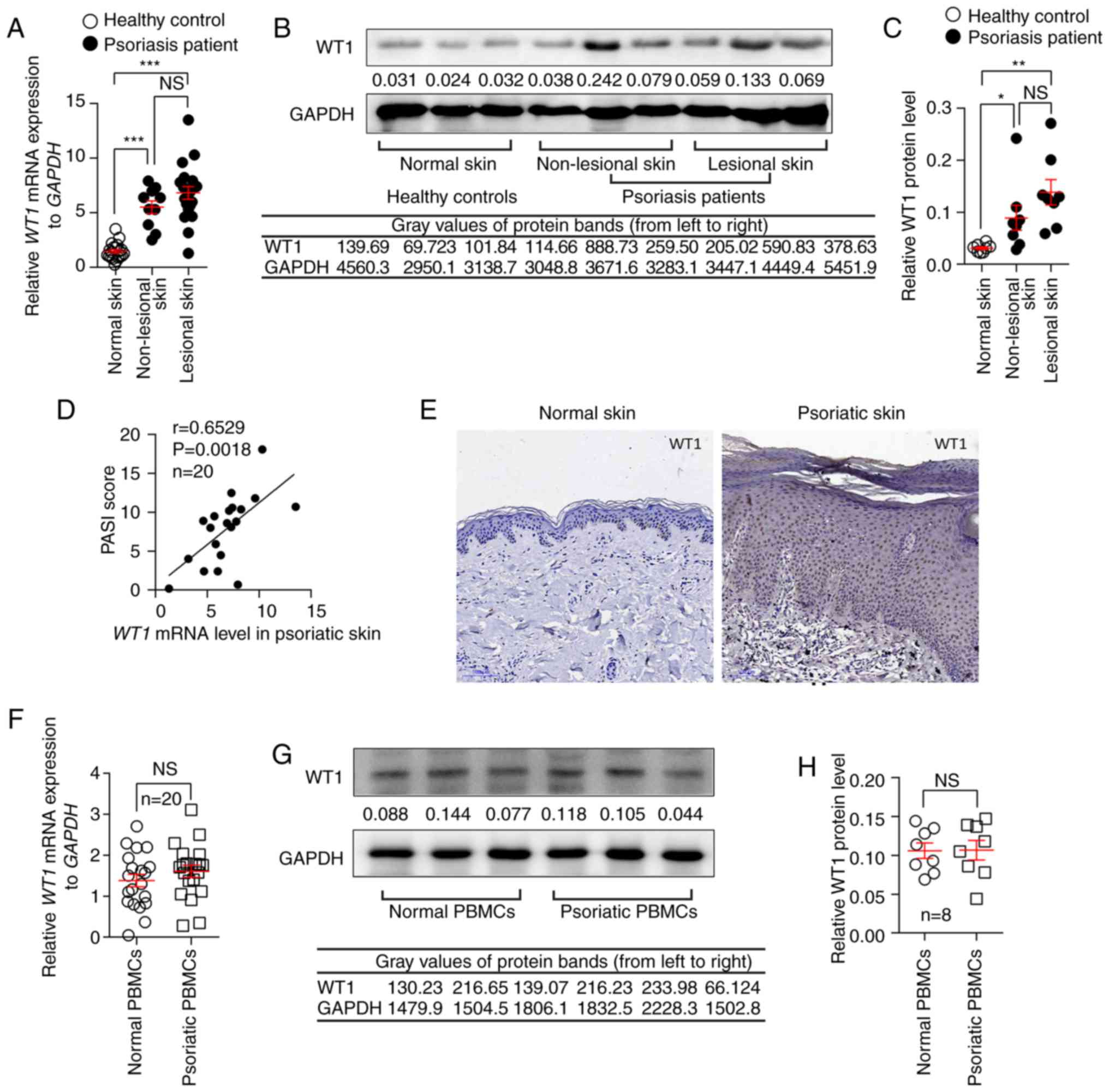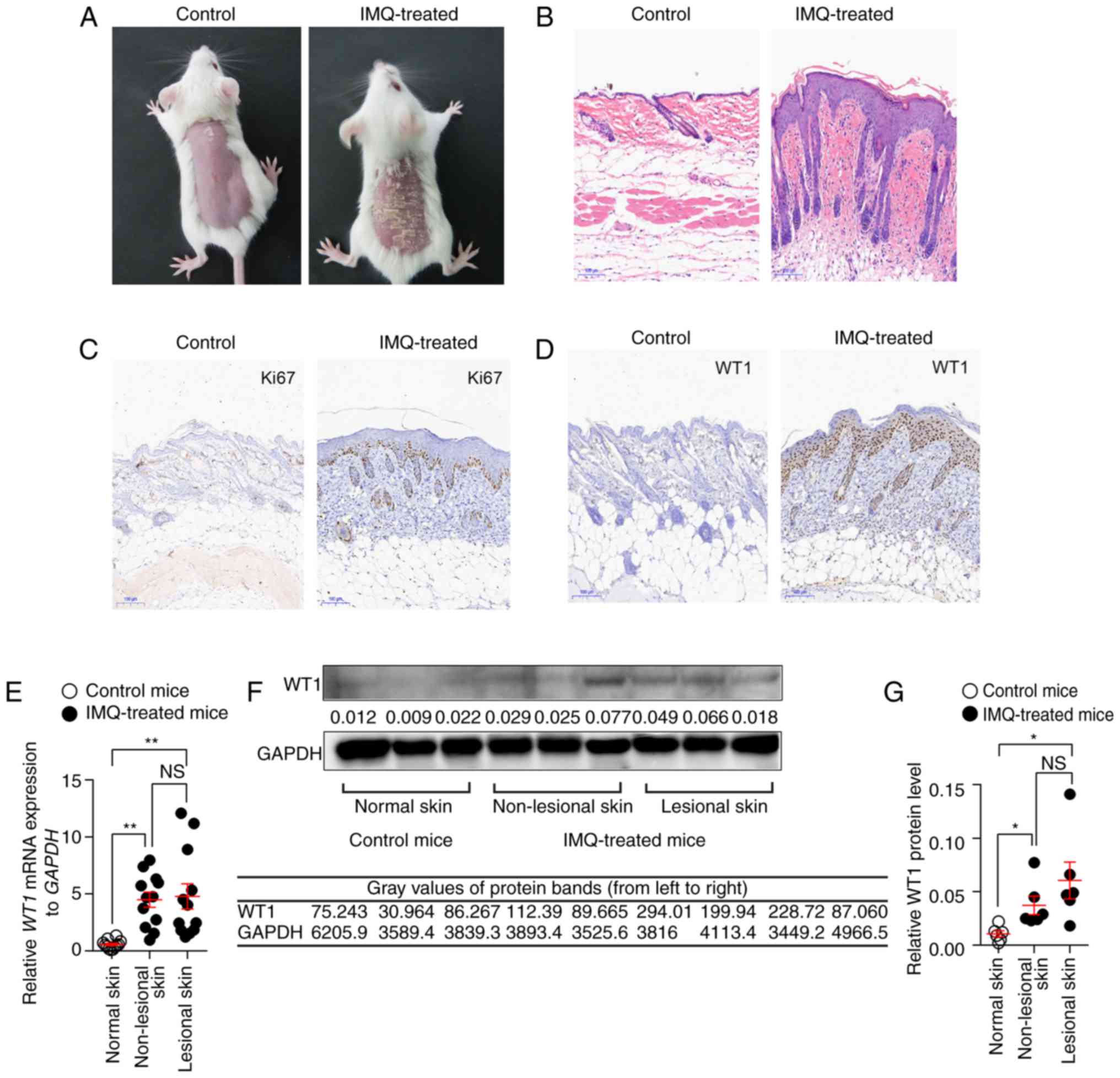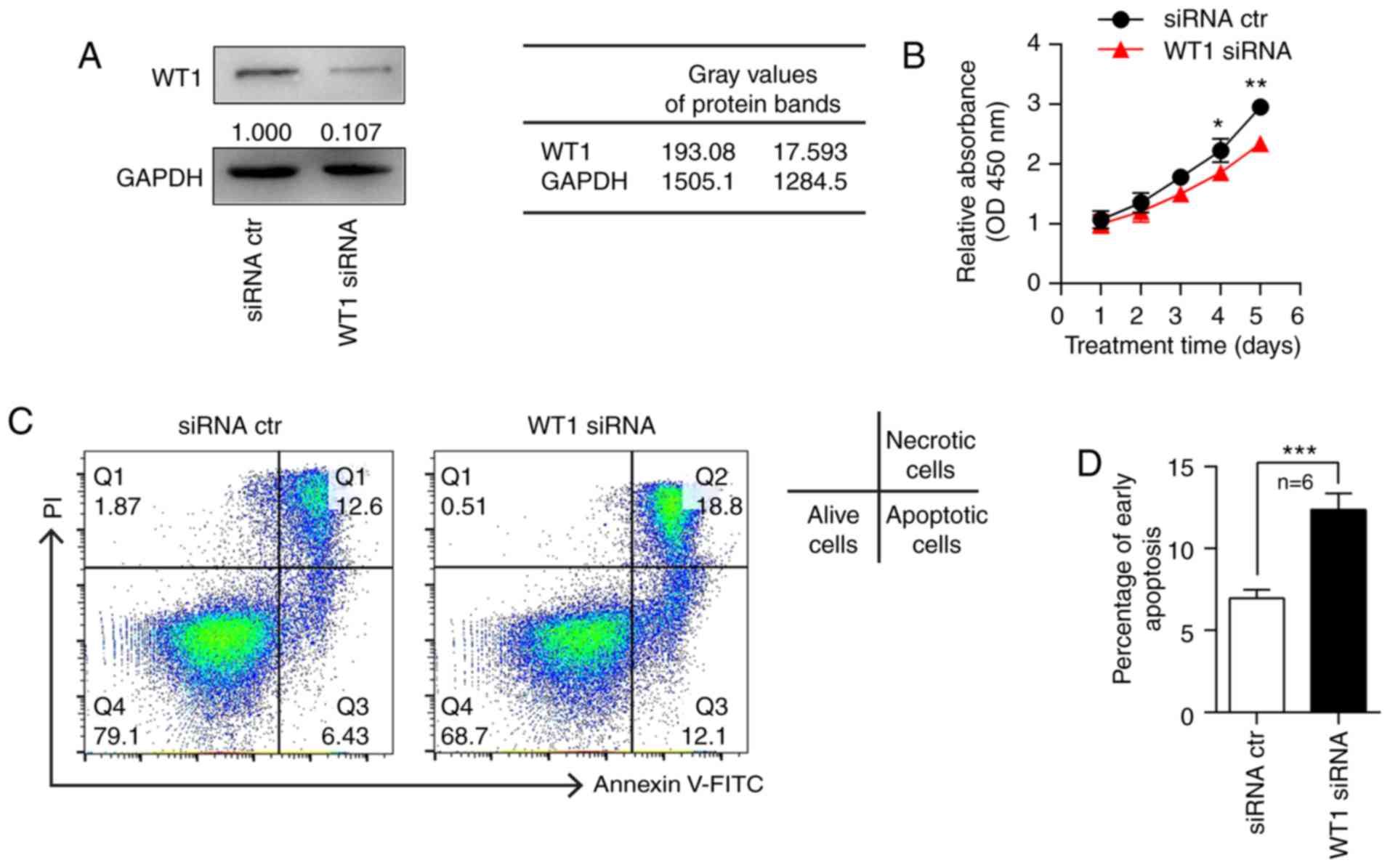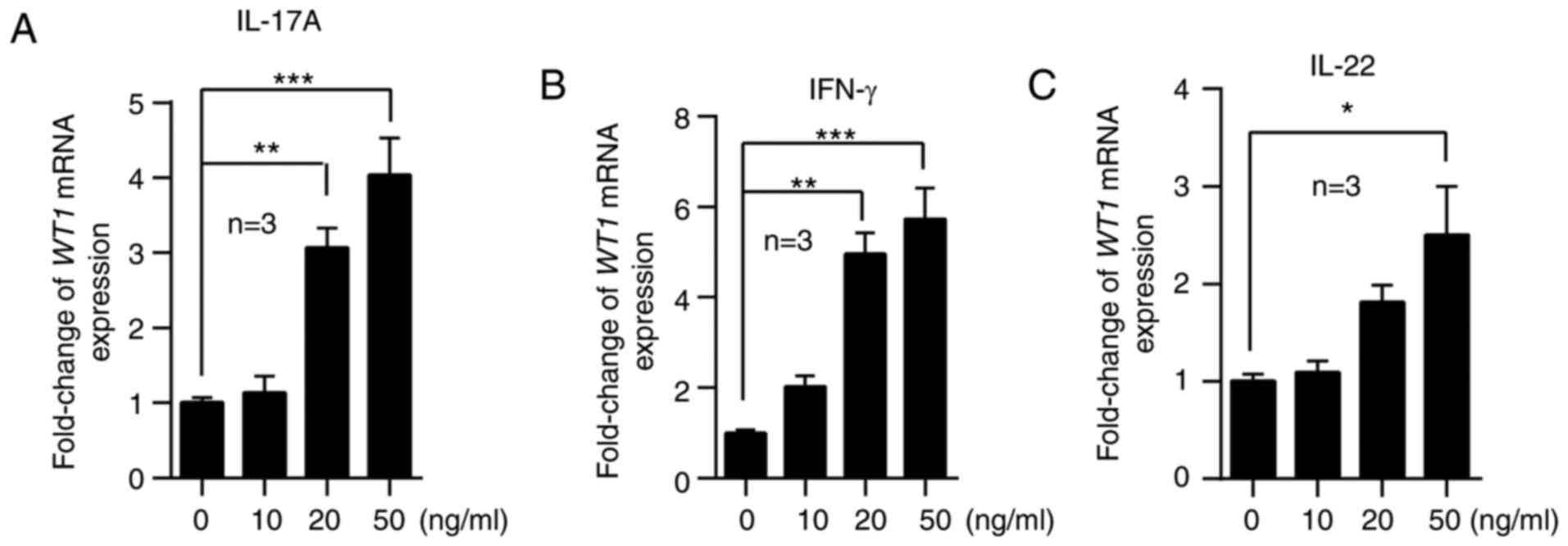|
1
|
Schön MP and Boehncke WH: Psoriasis. N
Engl J Med. 352:1899–1912. 2005. View Article : Google Scholar : PubMed/NCBI
|
|
2
|
Lowes MA, Bowcock AM and Krueger JG:
Pathogenesis and therapy of psoriasis. Nature. 445:866–873. 2007.
View Article : Google Scholar : PubMed/NCBI
|
|
3
|
Boehncke WH and Schön MP: Psoriasis.
Lancet. 386:983–994. 2015. View Article : Google Scholar : PubMed/NCBI
|
|
4
|
Suárez-Fariñas M, Li K, Fuentes-Duculan J,
Hayden K, Brodmerkel C and Krueger JG: Expanding the psoriasis
disease profile: Interrogation of the skin and serum of patients
with moderate-to-severe psoriasis. J Invest Dermatol.
132:2552–2564. 2012. View Article : Google Scholar : PubMed/NCBI
|
|
5
|
Tan NS, Michalik L, Noy N, Yasmin R, Pacot
C, Heim M, Flühmann B, Desvergne B and Wahli W: Critical roles of
PPAR beta/delta in keratinocyte response to inflammation. Genes
Dev. 15:3263–3277. 2001. View Article : Google Scholar : PubMed/NCBI
|
|
6
|
Croxford AL, Karbach S, Kurschus FC,
Wörtge S, Nikolaev A, Yogev N, Klebow S, Schüler R, Reissig S,
Piotrowski C, et al: IL-6 regulates neutrophil microabscess
formation in IL-17A-driven psoriasiform lesions. J Invest Dermatol.
134:728–735. 2014. View Article : Google Scholar : PubMed/NCBI
|
|
7
|
Uyemura K, Yamamura M, Fivenson DF, Modlin
RL and Nickoloff BJ: The cytokine network in lesional and
lesion-free psoriatic skin is characterized by a T-helper type 1
cell-mediated response. J Invest Dermatol. 101:701–705. 1993.
View Article : Google Scholar : PubMed/NCBI
|
|
8
|
Zaba LC, Suárez-Fariñas M, Fuentes-Duculan
J, Nograles KE, Guttman-Yassky E, Cardinale I, Lowes MA and Krueger
JG: Effective treatment of psoriasis with etanercept is linked to
suppression of IL-17 signaling, not immediate response TNF genes. J
Allergy Clin Immunol. 124:1022–1110.e1-e395. 2009. View Article : Google Scholar : PubMed/NCBI
|
|
9
|
Schön M, Behmenburg C, Denzer D and Schön
MP: Pathogenic function of IL-1 beta in psoriasiform skin lesions
of flaky skin (fsn/fsn) mice. Clin Exp Immunol. 123:505–510. 2001.
View Article : Google Scholar : PubMed/NCBI
|
|
10
|
Gisondi P, Gubinelli E, Cocuroccia B and
Girolomoni G: Targeting tumor necrosis factor-alpha in the therapy
of psoriasis. Curr Drug Targets Inflamm Allergy. 3:175–183. 2004.
View Article : Google Scholar : PubMed/NCBI
|
|
11
|
Green LM, Wagner KJ, Campbell HA, Addison
K and Roberts SG: Dynamic interaction between WT1 and BASP1 in
transcriptional regulation during differentiation. Nucleic Acids
Res. 37:431–440. 2009. View Article : Google Scholar : PubMed/NCBI
|
|
12
|
Park S, Tomlinson G, Nisen P and Haber DA:
Altered trans-activational properties of a mutated WT1 gene product
in a WAGR-associated Wilms' tumor. Cancer Res. 53:4757–4760.
1993.PubMed/NCBI
|
|
13
|
Bruening W, Gros P, Sato T, Stanimir J,
Nakamura Y, Housman D and Pelletier J: Analysis of the 11p13 Wilms'
tumor suppressor gene (WT1) in ovarian tumors. Cancer Invest.
11:393–399. 1993. View Article : Google Scholar : PubMed/NCBI
|
|
14
|
Silberstein GB, Van Horn K, Strickland P,
Roberts CT Jr and Daniel CW: Altered expression of the WT1 wilms
tumor suppressor gene in human breast cancer. Proc Natl Acad Sci
USA. 94:pp. 8132–8137. 1997; View Article : Google Scholar : PubMed/NCBI
|
|
15
|
Oji Y, Yano M, Nakano Y, Abeno S,
Nakatsuka S, Ikeba A, Yasuda T, Fujiwara Y, Takiguchi S, Yamamoto
H, et al: Overexpression of the Wilms' tumor gene WT1 in esophageal
cancer. Anticancer Res. 24:3103–3108. 2004.PubMed/NCBI
|
|
16
|
Keilholz U, Menssen HD, Gaiger A, Menke A,
Oji Y, Oka Y, Scheibenbogen C, Stauss H, Thiel E and Sugiyama H:
Wilms' tumour gene 1 (WT1) in human neoplasia. Leukemia.
19:1318–1323. 2005. View Article : Google Scholar : PubMed/NCBI
|
|
17
|
Oji Y, Nakamori S, Fujikawa M, Nakatsuka
S, Yokota A, Tatsumi N, Abeno S, Ikeba A, Takashima S, Tsujie M, et
al: Overexpression of the Wilms' tumor gene WT1 in pancreatic
ductal adenocarcinoma. Cancer Sci. 95:583–587. 2004. View Article : Google Scholar : PubMed/NCBI
|
|
18
|
Gao SM, Yang JJ, Chen CQ, Chen JJ, Ye LP,
Wang LY, Wu JB, Xing CY and Yu K: Pure curcumin decreases the
expression of WT1 by upregulation of miR-15a and miR-16-1 in
leukemic cells. J Exp Clin Cancer Res. 31:272012. View Article : Google Scholar : PubMed/NCBI
|
|
19
|
Loeb DM and Sukumar S: The role of WT1 in
oncogenesis: Tumor suppressor or oncogene? Int J Hematol.
76:117–126. 2002. View Article : Google Scholar : PubMed/NCBI
|
|
20
|
Hohenstein P and Hastie ND: The many
facets of the Wilms' tumour gene, WT1. Hum Mol Genet 15 Spec No.
2:R196–R201. 2006. View Article : Google Scholar
|
|
21
|
Huff V: Wilms' tumours: About tumour
suppressor genes, an oncogene and a chameleon gene. Nat Rev Cancer.
11:111–121. 2011. View
Article : Google Scholar : PubMed/NCBI
|
|
22
|
Armstrong AW, Parsi K, Schupp CW, Mease PJ
and Duffin KC: Standardizing training for psoriasis measures:
Effectiveness of an online training video on Psoriasis Area and
Severity Index assessment by physician and patient raters. JAMA
Dermatol. 149:577–582. 2013. View Article : Google Scholar : PubMed/NCBI
|
|
23
|
Malkic Salihbegovic E, Hadzigrahic N and
Cickusic AJ: Psoriasis and metabolic syndrome. Med Arch. 69:85–87.
2015. View Article : Google Scholar : PubMed/NCBI
|
|
24
|
van der Fits L, Mourits S, Voerman JS,
Kant M, Boon L, Laman JD, Cornelissen F, Mus AM, Florencia E, Prens
EP and Lubberts E: Imiquimod-induced psoriasis-like skin
inflammation in mice is mediated via the IL-23/IL-17 axis. J
Immunol. 182:5836–5845. 2009. View Article : Google Scholar : PubMed/NCBI
|
|
25
|
Livak KJ and Schmittgen TD: Analysis of
relative gene expression data using real-time quantitative PCR and
the 2(-Delta Delta C(T)) method. Methods. 25:402–408. 2001.
View Article : Google Scholar : PubMed/NCBI
|
|
26
|
Mak RK, Hundhausen C and Nestle FO:
Progress in understanding the immunopathogenesis of psoriasis.
Actas Dermosifiliogr. 100 Suppl 2:S2–S13. 2009. View Article : Google Scholar
|
|
27
|
Nestle FO, Kaplan DH and Barker J:
Psoriasis. N Engl J Med. 361:496–509. 2009. View Article : Google Scholar : PubMed/NCBI
|
|
28
|
Ragaz A and Ackerman AB: Evolution,
maturation, and regression of lesions of psoriasis. New
observations and correlation of clinical and histologic findings.
Am J Dermatopathol. 1:199–214. 1979. View Article : Google Scholar : PubMed/NCBI
|
|
29
|
Scharnhorst V, Dekker P, van der Eb AJ and
Jochemsen AG: Internal translation initiation generates novel WT1
protein isoforms with distinct biological properties. J Biol Chem.
274:23456–23462. 1999. View Article : Google Scholar : PubMed/NCBI
|
|
30
|
Yang L, Han Y, Suarez Saiz F and Minden
MD: A tumor suppressor and oncogene: The WT1 story. Leukemia.
21:868–876. 2007. View Article : Google Scholar : PubMed/NCBI
|
|
31
|
Scharnhorst V, van der Eb AJ and Jochemsen
AG: WT1 proteins: Functions in growth and differentiation. Gene.
273:141–161. 2001. View Article : Google Scholar : PubMed/NCBI
|
|
32
|
Wagner KD, Cherfils-Vicini J, Hosen N,
Hohenstein P, Gilson E, Hastie ND, Michiels JF and Wagner N: The
Wilms' tumour suppressor Wt1 is a major regulator of tumour
angiogenesis and progression. Nat Commun. 5:58522014. View Article : Google Scholar : PubMed/NCBI
|
|
33
|
Algar EM, Khromykh T, Smith SI, Blackburn
DM, Bryson GJ and Smith PJ: A WT1 antisense oligonucleotide
inhibits proliferation and induces apoptosis in myeloid leukaemia
cell lines. Oncogene. 12:1005–1014. 1996.PubMed/NCBI
|
|
34
|
Yamagami T, Sugiyama H, Inoue K, Ogawa H,
Tatekawa T, Hirata M, Kudoh T, Akiyama T, Murakami A and Maekawa T:
Growth inhibition of human leukemic cells by WT1 (Wilms tumor gene)
antisense oligodeoxynucleotides: Implications for the involvement
of WT1 in leukemogenesis. Blood. 87:2878–2884. 1996.PubMed/NCBI
|
|
35
|
Tatsumi N, Oji Y, Tsuji N, Tsuda A,
Higashio M, Aoyagi S, Fukuda I, Ito K, Nakamura J, Takashima S, et
al: Wilms' tumor gene WT1-shRNA as a potent apoptosis-inducing
agent for solid tumors. Int J Oncol. 32:701–711. 2008.PubMed/NCBI
|
|
36
|
Xu C, Wu C, Xia Y, Zhong Z, Liu X, Xu J,
Cui F, Chen B, Røe OD, Li A and Chen Y: WT1 promotes cell
proliferation in non-small cell lung cancer cell lines through
up-regulating cyclin D1 and p-pRb in vitro and in vivo. PLoS One.
8:e688372013. View Article : Google Scholar : PubMed/NCBI
|
|
37
|
Hewitt SM, Hamada S, McDonnell TJ,
Rauscher FJ III and Saunders GF: Regulation of the proto-oncogenes
bcl-2 and c-myc by the Wilms' tumor suppressor gene WT1. Cancer
Res. 55:5386–5389. 1995.PubMed/NCBI
|
|
38
|
Maheswaran S, Englert C, Bennett P,
Heinrich G and Haber DA: The WT1 gene product stabilizes p53 and
inhibits p53-mediated apoptosis. Genes Dev. 9:2143–2156. 1995.
View Article : Google Scholar : PubMed/NCBI
|
|
39
|
Li X, Li Y, Yuan T, Zhang Q, Jia Y, Li Q,
Huai L, Yu P, Tian Z, Tang K, et al: Exogenous expression of WT1
gene influences U937 cell biological behaviors and activates MAPK
and JAK-STAT signaling pathways. Leuk Res. 38:931–939. 2014.
View Article : Google Scholar : PubMed/NCBI
|
|
40
|
Kim BH, Lee JM, Jung YG, Kim S and Kim TY:
Phytosphingosine derivatives ameliorate skin inflammation by
inhibiting NF-κB and JAK/STAT signaling in keratinocytes and mice.
J Invest Dermatol. 134:1023–1032. 2014. View Article : Google Scholar : PubMed/NCBI
|
|
41
|
Moorchung N, Vasudevan B, Dinesh Kumar S
and Muralidhar A: Expression of apoptosis regulating proteins p53
and bcl-2 in psoriasis. Indian J Pathol Microbiol. 58:423–426.
2015. View Article : Google Scholar : PubMed/NCBI
|
|
42
|
Casado M, Martin M, Muñoz A and Bernal J:
Vitamin D3 inhibits proliferation and increases c-myc expression in
fibroblasts from psoriatic patients. J Endocrinol Invest.
21:520–525. 1998. View Article : Google Scholar : PubMed/NCBI
|
|
43
|
Zang XP, Pento JT and Tari AM: Wilms'
tumor 1 protein and focal adhesion kinase mediate keratinocyte
growth factor signaling in breast cancer cells. Anticancer Res.
28:133–137. 2008.PubMed/NCBI
|
|
44
|
Kovacs D, Falchi M, Cardinali G, Raffa S,
Carducci M, Cota C, Amantea A, Torrisi MR and Picardo M:
Immunohistochemical analysis of keratinocyte growth factor and
fibroblast growth factor 10 expression in psoriasis. Exp Dermatol.
14:130–137. 2005. View Article : Google Scholar : PubMed/NCBI
|
|
45
|
Wu R, Zeng J, Yuan J, Deng X, Huang Y,
Chen L, Zhang P, Feng H, Liu Z, Wang Z, et al: MicroRNA-210
overexpression promotes psoriasis-like inflammation by inducing Th1
and Th17 cell differentiation. J Clin Invest. 128:2551–2568. 2018.
View Article : Google Scholar : PubMed/NCBI
|
|
46
|
Yan S, Xu Z, Lou F, Zhang L, Ke F, Bai J,
Liu Z, Liu J, Wang H, Zhu H, et al: NF-κB-induced microRNA-31
promotes epidermal hyperplasia by repressing protein phosphatase 6
in psoriasis. Nat Commun. 6:76522015. View Article : Google Scholar : PubMed/NCBI
|
|
47
|
Goldminz AM, Au SC, Kim N, Gottlieb AB and
Lizzul PF: NF-κB: An essential transcription factor in psoriasis. J
Dermatol Sci. 69:89–94. 2013. View Article : Google Scholar : PubMed/NCBI
|
|
48
|
Hang do TT, Song JY, Kim MY, Park JW and
Shin YK: Involvement of NF-κB in changes of IFN-γ-induced
CIITA/MHC-II and iNOS expression by influenza virus in macrophages.
Mol Immunol. 48:1253–1262. 2011. View Article : Google Scholar : PubMed/NCBI
|
|
49
|
Wu Y, Zhu L, Liu L, Zhang J and Peng B:
Interleukin-17A stimulates migration of periodontal ligament
fibroblasts via p38 MAPK/NF-κB-dependent MMP-1 expression. J Cell
Physiol. 229:292–299. 2014. View Article : Google Scholar : PubMed/NCBI
|
|
50
|
Gelebart P, Zak Z, Dien-Bard J, Anand M
and Lai R: Interleukin 22 signaling promotes cell growth in mantle
cell lymphoma. Transl Oncol. 4:9–19. 2011. View Article : Google Scholar : PubMed/NCBI
|














